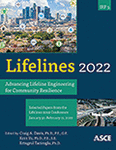The Economic Effects of the HayWired Scenario Using the Association of Bay Area Governments Regional Growth Forecast—A Focus on Network Disruption and Resilience
Publication: Lifelines 2022
ABSTRACT
This paper describes how impacts to infrastructure networks within the San Francisco Bay Area may exacerbate the effects of building damage and how policies addressing these networks can improve resilience before and after the earthquake. The analysis uses existing modeling techniques that underlie the Association of Bay Area Government’s (ABAG) 2015 regional economic forecast of the San Francisco Bay region, California to estimate how a moment magnitude (MW) 7.0 earthquake scenario along the Hayward Fault, HayWired, would change the trajectory of that forecast. The ABAG forecast released in January 2015 is built on the framework of a Regional Economic Models, Inc. (REMI) model for the San Francisco Bay region and projects growth in the bay area through 2040. Using the simulation tools in the REMI model, the analysis applies the direct output losses flowing from building damages from the HayWired scenario (estimated using the FEMA Hazus model) to ABAG’s economic and demographic 2015 regional forecast. Also the analysis estimates direct, indirect, and induced effects on gross regional product (GRP), employment and population, and also highlights the effects of the physical infrastructure damage to roads, bridges, and rail to the region’s economy. Communications infrastructure, if resilient or restored, can help counteract the losses generated by building and transportation network damage. The REMI model results show that in the first year, employment would drop by almost half a million jobs, whereas GRP would decline by 8 percent. The two counties near the epicenter of the earthquake would have greater losses, of 15 percent in jobs and 13 percent in GRP. Counties with less physical damage may still have economic slowdowns due to transportation disruption. Much of the economy could recover within a few years, but a full return to the projected trajectory could take more than five years for the region and closer to a decade for the most severely affected counties. Recovery and rebuilding investments will be crucial to repairing the economic base of the region and returning it to its projected growth trajectory. State and local policies, as well as business and personal preparedness and employer flexibility in allowing remote work can reduce the length and severity of effects. Furthermore, sensitivity analyses using the model identify some critical factors that would lead to different levels of change. For example, a shortage of construction workers could result in a deeper, longer recession as rebuilding is postponed. Should major technology employers decide to relocate substantial portions of operations or expand outside of the region, the recovery period from the earthquake induced recession could stretch to six or seven years and the region’s trajectory could be permanently damped relative to the ABAG 2015 forecast for 2040.
Get full access to this article
View all available purchase options and get full access to this chapter.
REFERENCES
Detweiler, S. T., and Wein, A. M., eds. (2020). The HayWired Earthquake Scenario—Societal Consequences. United States Geological Survey, <https://pubs.er.usgs.gov/publication/sir20175013V3>(Jun. 20, 2021).
Johnson, L. A., Jones, J. L., Wein, A. M., and Peters, J. A. (2020). “Analysis of communities at risk in the HayWired Scenario.” Chapter U in The HayWired earthquake scenario—Societal consequences, S. T. Detweiler and A. M. Wein, eds. United States Geological Survey Scientific Investigations Report 2017–5013–R–W, 139 p.
Jones, J. L., Wein, A. M., Schweikert, A. E., and Ballanti, L. R. (2020). “Lifeline Infrastructure and Collocation Exposure to the HayWired Earthquake Scenario—A Summary of Hazards and Potential Service Disruptions”. Chapter T in The HayWired earthquake scenario—Societal consequences, S. T. Detweiler and A. M. Wein, eds. United States Geological Survey Scientific Investigations Report 2017–5013–R–W, 104p.
Kroll, C., Lu, S. B., Olsen, A., and Wein, A. (2020). “The Economic Effects of the HayWired Scenario Using the Association of Bay Area Governments Regional Growth Forecast.” Chapter V3 in The HayWired earthquake scenario—Societal consequences, S. T. Detweiler and A. M. Wein, eds. United States Geological Survey Scientific Investigations Report 2017–5013–R–W, 58p.
Levy, S., Wein, A. M., and Kroll, C. (2020). “Summary of Economic Impact Analyses and Policy Implications of the HayWired Scenario”. Chapter V1 in The HayWired earthquake scenario—Societal consequences, S.T. Detweiler and A.W. Wein, eds. United States Geological Survey Scientific Investigations Report 2017–5013–R–W, 82 p.
Littlehale, S. (2019). Rebuilding California: The Golden State’s Housing Workforce Reckoning, January 2019. <https://www.smartcitiesprevail.org/wp-content/uploads/2019/01/SCP_HousingReport.0118_2.pdf>(Feb. 25, 2020).
Seligson, H. A., Wein, A. M., and Jones, J. L. (2018). “HayWired scenario—Hazus analyses of the mainshock and aftershocks.” Chapter J in The HayWired earthquake scenario—Engineering implications, Detweiler, S. T., and Wein, A. M., eds. United States Geological Survey Scientific Investigations Report 2017–5013–I–Q, 429 p. <https://doi.org/10.3133/sir20175013v2>(Feb. 20, 2020).
Sue Wing, I., Wei, D., Rose, A. Z., and Wein, A. M. (2021). “Economic Consequences of the HayWired Earthquake Scenario—Digital and Utility Network Linkages and Resilience.” Chapter V2 in The HayWired earthquake scenario—Societal consequences, S. T. Detweiler and A. M. Wein, eds. United States Geological Survey Scientific Investigations Report 2017–5013–R–W, 82 p.
Wein, A. M., Belzer, D., Kroll, C., Au, C., Jones, J. L., Johnson, L., Olsen, A., and Peters, J. (2020). “Spatial Analysis of Industries, Employment, and Commute Flows in Areas of Concentrated Damage from the HayWired Earthquake Scenario.” Chapter V5 in The HayWired earthquake scenario—Societal consequences, S. T. Detweiler and A. M. Wein, eds. U.S. Geological Survey Scientific Investigations Report 2017–5013–R–W, 57 p.
Wein, A. M., Haveman, J., Kroll, C., and Peters, J. (2020). “Characteristics of Businesses Disrupted by Building Damages from the HayWired Scenario Mainshock.” Chapter V4 in The HayWired Earthquake Scenario—Societal Consequences, S. T. Detweiler and A. M. Wein, eds. United States Geological Survey Scientific Investigations Report 2017–5013–R–W, 68 p.
Information & Authors
Information
Published In
History
Published online: Nov 16, 2022
Authors
Metrics & Citations
Metrics
Citations
Download citation
If you have the appropriate software installed, you can download article citation data to the citation manager of your choice. Simply select your manager software from the list below and click Download.
